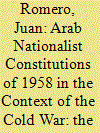| Srl | Item |
| 1 |
ID:
174899


|
|
|
|
|
| Summary/Abstract |
Unlike many works on constitutions, this article focuses on non-legal aspects of the framing of Arab constitutions. This emphasis on the social and political in lieu of purely legal aspects of constitution-making allows us to place constitutions in a wider regional and not merely national context, and interpret them from a not strictly legal perspective. By adopting such an approach, historians can explain the extent to which the turbulence in the Arab world in the 1950s as a result of Arab nationalism, the creation of the state of Israel, the rivalry between revolutionary and monarchic Arab regimes, and the Cold War affected three Arab organic laws in the revolutionary year of 1958. This focus on contemporary social and political developments enables scholars to explain why the three different fundamental laws examined here reflect three different interpretations of Arab nationalism.
|
|
|
|
|
|
|
|
|
|
|
|
|
|
|
|
| 2 |
ID:
174596


|
|
|
|
|
| Summary/Abstract |
The decade of 1950–60 was unique in terms of the establishment of a supranational Arab union, known as the United Arab Republic. However, this union was ill born due to certain frictions between Arab states in the Middle East. There were divergences between the visions of Arab Nationalism for each state and this caused a troubling process for this supranational initiative. This study considers these frictions as the main reasons behind why the UAR was an unsuccessful attempt and further why the Arab Nationalism dissolved afterwards. The divergence between two competing visions of Arab Nationalism is symbolized through the competition between Iraqi prime minister Abd al-Karim Qasim and Egyptian president Gamal Nasser. The domestic, regional and global circumstances for these two countries and their leaders are analyzed in order to illustrate how these frictions became a reality and divided the Arab stance.
|
|
|
|
|
|
|
|
|
|
|
|
|
|
|
|
| 3 |
ID:
046437


|
|
|
|
|
| Publication |
Boulder, Lynne Rienner Publishers, 2002.
|
| Description |
vii, 235p.hbk
|
| Standard Number |
1588260348
|
|
|
|
|
|
|
|
|
|
|
|
Copies: C:1/I:0,R:0,Q:0
Circulation
| Accession# | Call# | Current Location | Status | Policy | Location |
| 045348 | 962.053/JAN 045348 | Main | On Shelf | General | |
|
|
|
|